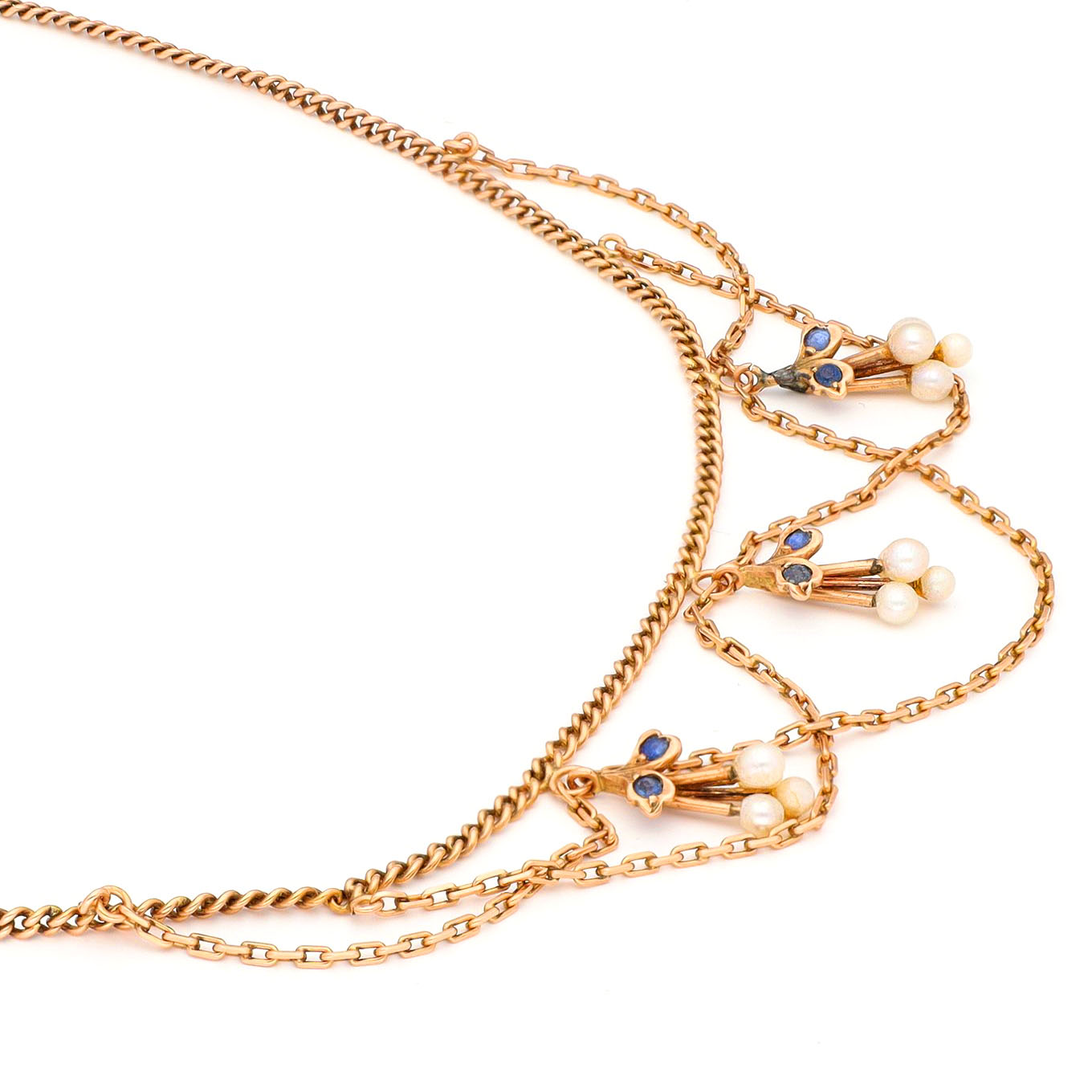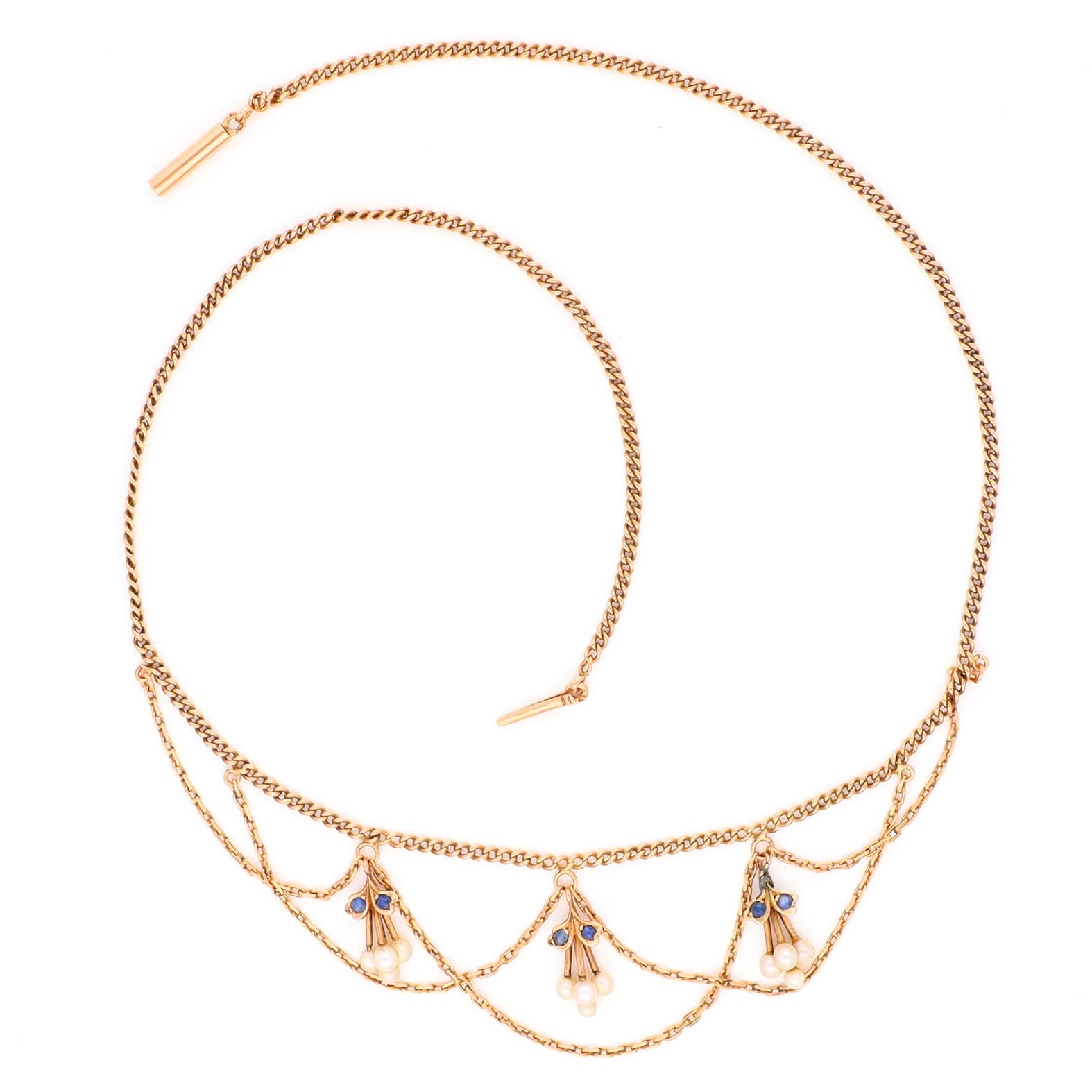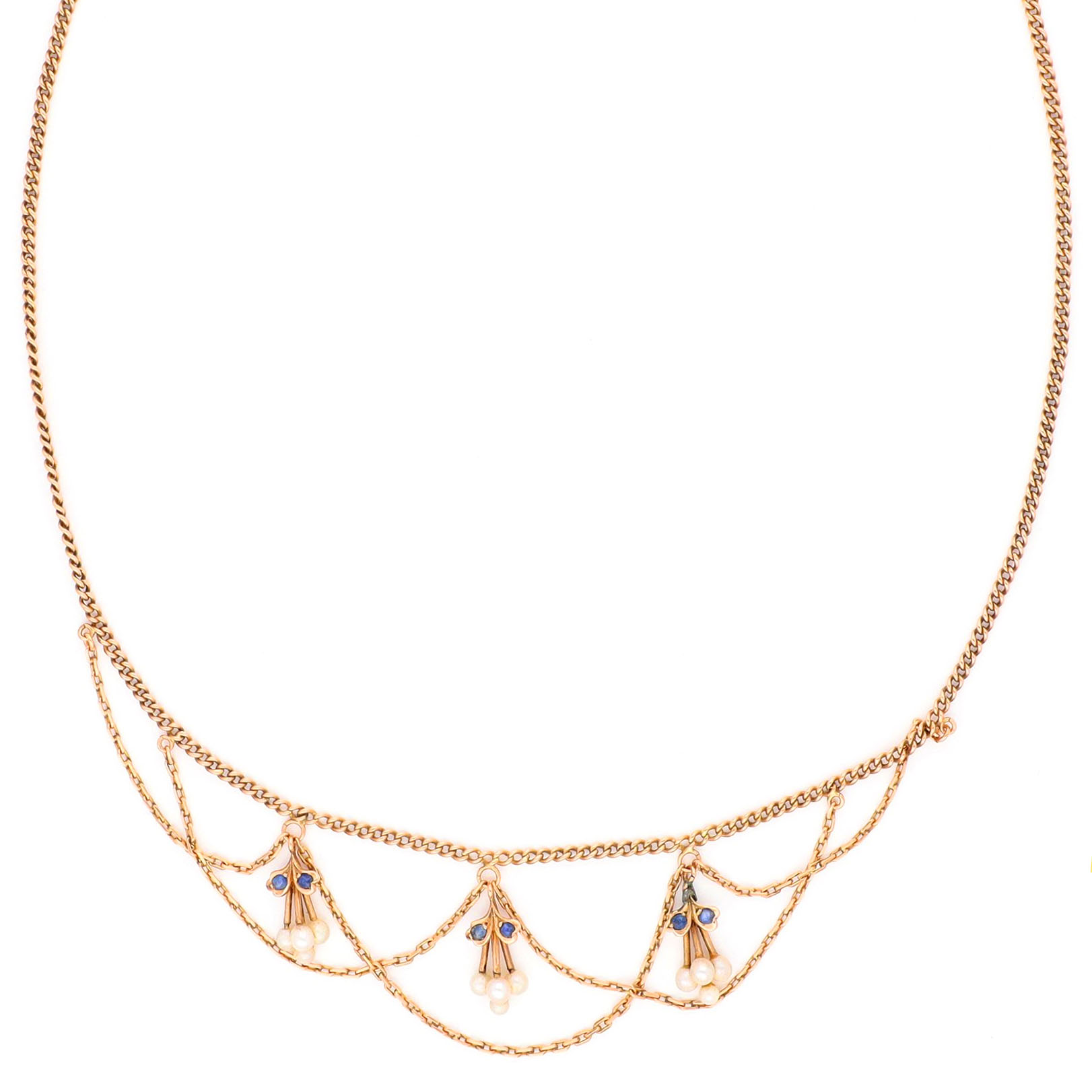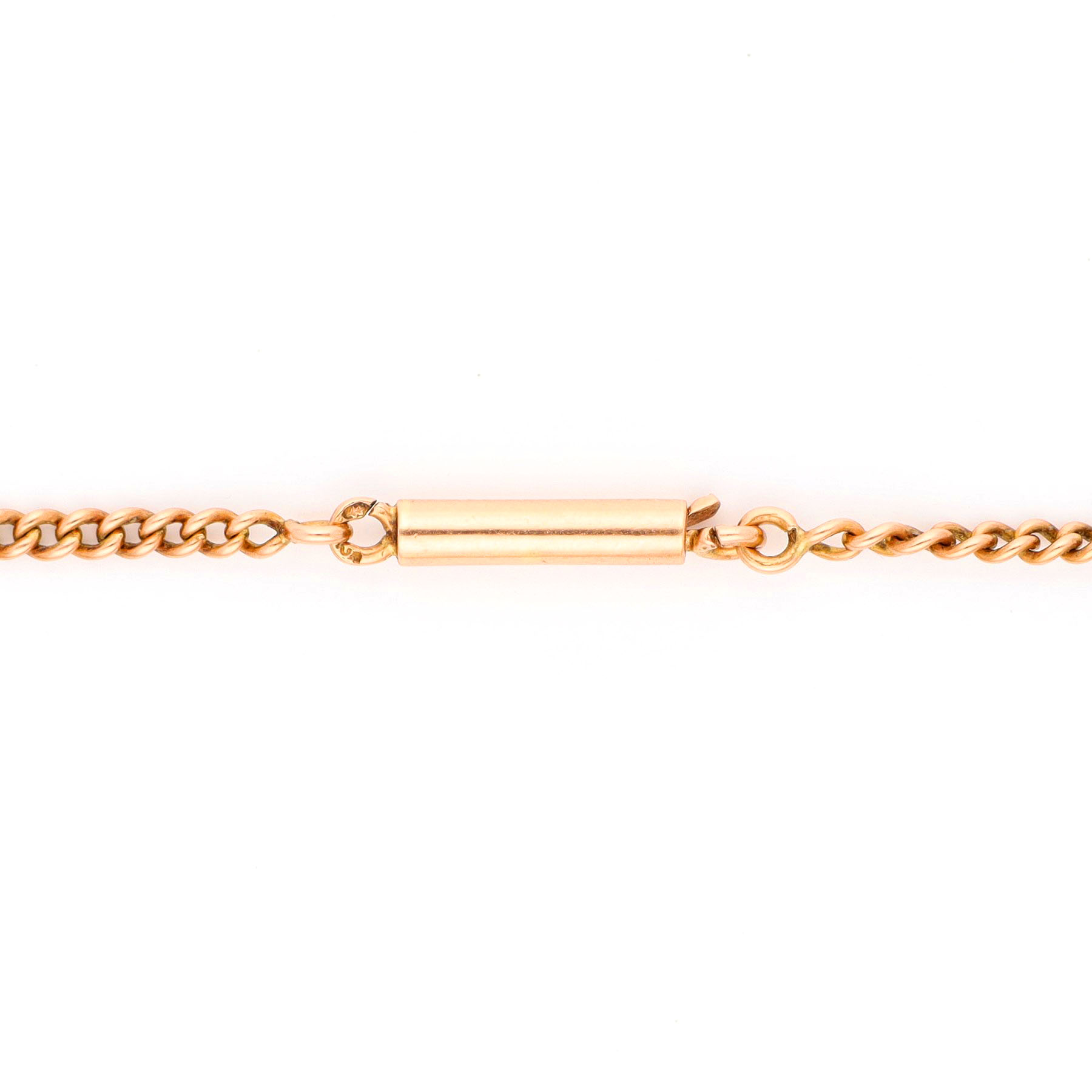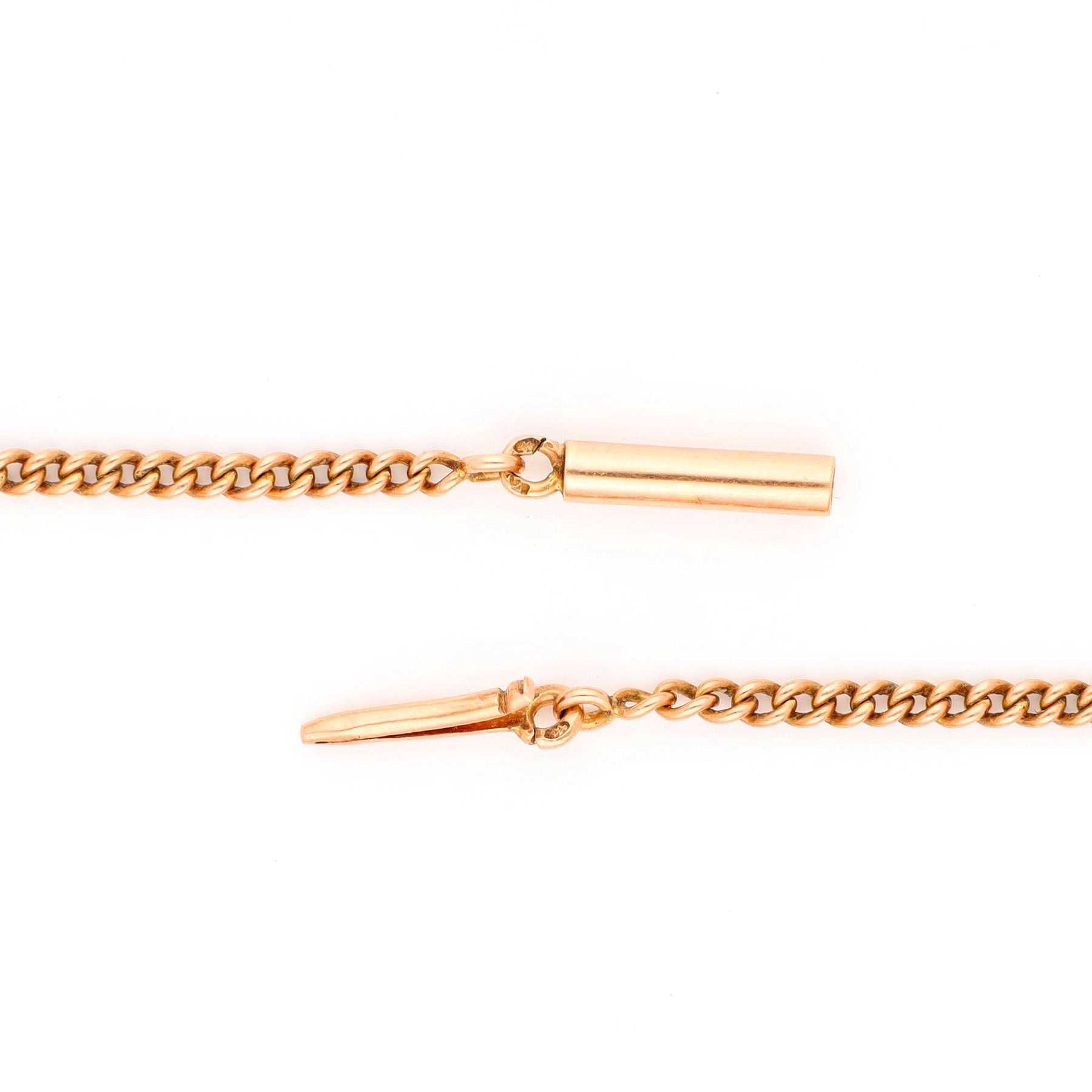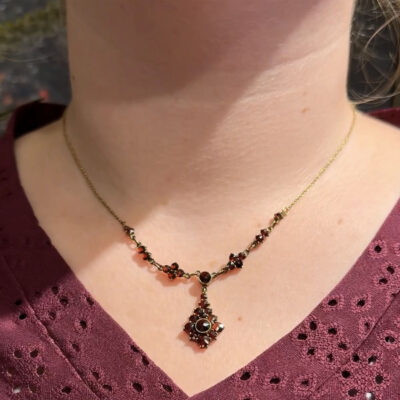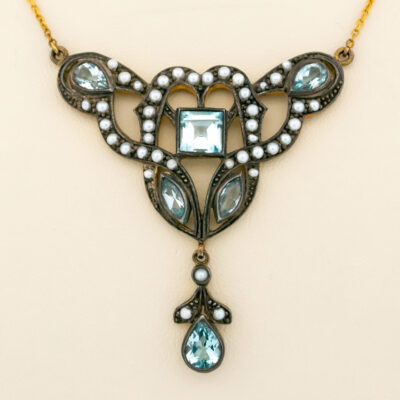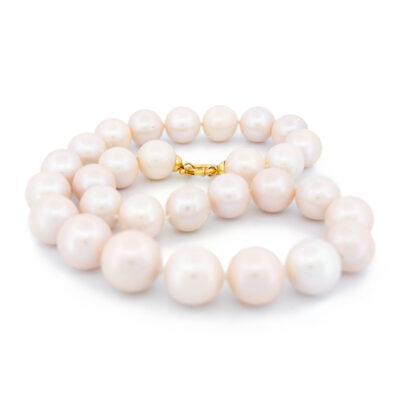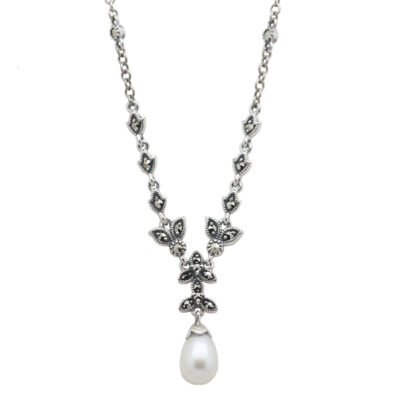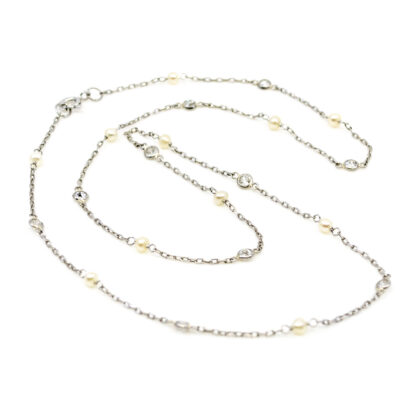A graceful Dutch ca.1900 festoon necklace, crafted in 14k yellow gold, drapes elegantly with clusters of 2.5–3 mm pearls accented by delicate blue sapphires (≈0.15ct). A refined piece of antique charm with timeless beauty. 🌿💎
A graceful Dutch ca.1900 festoon necklace, crafted in 14k yellow gold, drapes elegantly with clusters of 2.5–3 mm pearls accented by delicate blue sapphires (≈0.15ct). A refined piece of antique charm with timeless beauty. 🌿💎
Details: ±2.5 to 3 mm Pearls, ±0.15ct Sapphires, 14k Necklace
Dimensions: Length 40 cm, diameter sapphires: approx. ø 1.5 mm, diameter pearls: approx. 2.4 – 3 mm.
Weight in grams: 9,4.
Condition: Very good condition – slightly used with small signs of wear.
| Design Era | |
|---|---|
| Design & Historical Context | The term "antique" refers to something that is more than 100 years old, and this includes jewelry that was created and used over several decades or eras. Antique jewelry can include pieces from a variety of different time periods, such as the Georgian, Victorian, Edwardian, and Art Deco periods. Each of these periods is characterized by its own unique style and artistic movements, and antique jewelry from these periods is often highly sought after by collectors and enthusiasts. Georgian jewelry, for example, is known for its intricate detailing and use of precious materials such as gold and diamonds, and is often influenced by the Baroque, Rococo, and Neoclassical styles. Victorian jewelry, on the other hand, is known for its intricate detailing and use of precious materials such as gold and diamonds, and is often influenced by the Romantic and Gothic styles. Edwardian jewelry is characterized by its delicate and intricate detailing, and is often influenced by the Art Nouveau, the Arts and Crafts movement, and the Belle Époque. Antique jewelry is often highly collectible and is valued for its unique style, craftsmanship, and historical significance. It can be found at antique shops, vintage stores, and online marketplaces. |
| Key Materials | |
| Materials & Craftsmanship | Pearl: The Gem of Elegance and Purity Pearls, with their natural luster and timeless beauty, are one of the most revered gemstones in the world. Unlike other gems, pearls are organic, formed within the soft tissue of mollusks like oysters and mussels. Their formation process results in a smooth, round gem with a soft, iridescent glow, often referred to as the "pearl essence." Historically, pearls have been a symbol of purity, wisdom, and wealth. In ancient Rome, they were considered the ultimate status symbol, while in ancient China, pearls were believed to protect against fire and dragons. During the Renaissance, pearls were so highly valued that they were reserved for royalty and nobility, symbolizing perfection and integrity. In modern jewelry, pearls are cherished for their classic elegance and versatility. They are commonly found in a range of colors, from the traditional white and cream to rare black, pink, and golden hues. Pearls are often strung into necklaces, set into earrings, or used as delicate accents in rings and bracelets. Their softness, with a Mohs hardness of 2.5 to 4.5, requires gentle care, but their beauty and sophistication are unmatched. Pearls are more than just a gem; they are a symbol of grace, purity, and timeless style. Their natural origins and understated elegance make them a beloved choice for jewelry that exudes refinement and sophistication. Sapphire: The Gem of Wisdom and Royalty Sapphire, known for its stunning deep blue color, is a gemstone that embodies wisdom, loyalty, and nobility. This precious stone is a variety of the mineral corundum, and while blue is the most famous color, sapphires can also be found in a range of hues, including pink, yellow, green, and even colorless. Historically, sapphire has been revered across cultures for its association with the divine and the eternal. In ancient Persia, it was believed that the sky was painted blue by the reflection of sapphire stones. Throughout the ages, sapphire has been favored by royalty and clergy as a symbol of purity, virtue, and divine favor. Perhaps the most famous modern example is the sapphire engagement ring worn by Princess Diana and now by the Duchess of Cambridge. In jewelry, sapphire is celebrated for its beauty and durability, boasting a Mohs hardness of 9, second only to diamond. This makes sapphire an excellent choice for rings, necklaces, and earrings intended for everyday wear. The stone’s intense color and clarity are often highlighted by settings in white gold or platinum, though yellow gold can also enhance its warmth and depth. Sapphire is more than just a gemstone; it is a symbol of wisdom, fidelity, and nobility. Its rich history, combined with its remarkable durability and beauty, makes it a timeless and elegant choice for jewelry that signifies enduring love and commitment. 14k: The Durable Choice for Everyday Elegance 14k gold is a popular and practical choice in fine jewelry, known for its durability, affordability, and beautiful color. The "14k" signifies that the gold is composed of 58.3% pure gold and 41.7% alloyed metals, such as copper, silver, nickel, or zinc. This combination results in a strong and resilient material that can withstand the rigors of daily wear, making it an ideal option for those seeking both beauty and durability. Historically, gold has always been a symbol of wealth and luxury, and 14k gold strikes a perfect balance between the rich appearance of gold and the strength needed for everyday use. Because of its lower gold content compared to 18k or 24k gold, 14k gold is more affordable, making it a popular choice for a wide range of jewelry pieces. In modern jewelry, 14k gold is appreciated for its versatility and variety. It is available in several colors, each achieved by mixing gold with different metals: Yellow Gold: A classic and timeless choice, 14k yellow gold has a warm, golden hue that complements most skin tones and is well-suited for both modern and traditional designs. White Gold: Created by alloying gold with white metals like nickel or palladium, 14k white gold has a sleek, silver-like appearance. It is often rhodium-plated for added shine and is a popular choice for engagement rings and other contemporary jewelry. Rose Gold: Achieved by mixing gold with copper, 14k rose gold has a soft, pinkish hue that has gained popularity for its romantic and vintage appeal. It is a favorite for those seeking a unique and stylish alternative to traditional gold colors. 14k gold is commonly used in a wide array of jewelry, including rings, necklaces, bracelets, earrings, and watches. Its durability makes it especially suitable for pieces that are worn daily, such as wedding bands and engagement rings, where the balance between strength and beauty is crucial. 14k gold is more than just a practical choice; it is a symbol of enduring style and everyday luxury. Its ability to retain the look of gold while offering greater resistance to scratches and dents makes 14k gold a versatile and timeless option for any jewelry collection. Whether in a simple band or an elaborate design, 14k gold offers a perfect blend of elegance and durability that can be enjoyed for years to come. |
| Dimensions | Length 40 cm, diameter sapphires: approx. ø 1.5 mm, diameter pearls: approx. 2.4 – 3 mm |
| Gender | |
| Weight (in grams) | 9,4 |
| Condition | Very good condition – slightly used with small signs of wear |
By following these tips, you can enjoy your precious jewelry for many years to come.
Related Products
-
Garnet 10k Festoon Necklace 14896-8396
€ 895,00 VAT incl. (where applicable) -
18k Pearl “Classic Single-Strand Pearl” Necklace 17518-9221
€ 1.695,00 VAT incl. (where applicable) -
Topaz Pearl 9k Silver Lavalier Necklace 10223-6515
€ 1.495,00 VAT incl. (where applicable) -
Pearl 18k “Single-Strand Pearl” Necklace 17525-9228
€ 4.995,00 VAT incl. (where applicable) -
Marcasite (Pyrite) Pearl 925′ Silver Pendant Necklace 18414-3477
€ 75,00 VAT incl. (where applicable) -
Marcasite (Pyrite) Pearl 925′ Silver Lavalier Necklace 17894-3221
€ 165,00 VAT incl. (where applicable) -
Diamond Pearl Platinum “Station” Necklace 9984-6211
€ 2.495,00 VAT incl. (where applicable) -
Diamond Platinum Festoon Necklace 11149-6268
€ 2.495,00 VAT incl. (where applicable)
- Home
- Collection
- Fine Jewelry
- Silver Jewelry
- Silverware
- Boxes
- Candlesticks
- Salt and pepper shakers
- Miniatures
- Salt cellars
- Spoon Set
- Condiments
- Frames
- Napkin Ring
- Spoon
- Oddities
- Cups
- Vases
- Cutlery
- Serving Spoon And Cake Server
- Candlesticks
- Baskets
- Hanukkiah
- Spice Tower
- Yad
- Tea Set
- Sugar Castor
- Napkin Rings
- Wine Bottle Coaster
- Wine Stopper
- Tea Pot
- Jugs
- Rattles
- Hip Flask
- Miscellaneous
- Rings 💍
- About
- Contact
